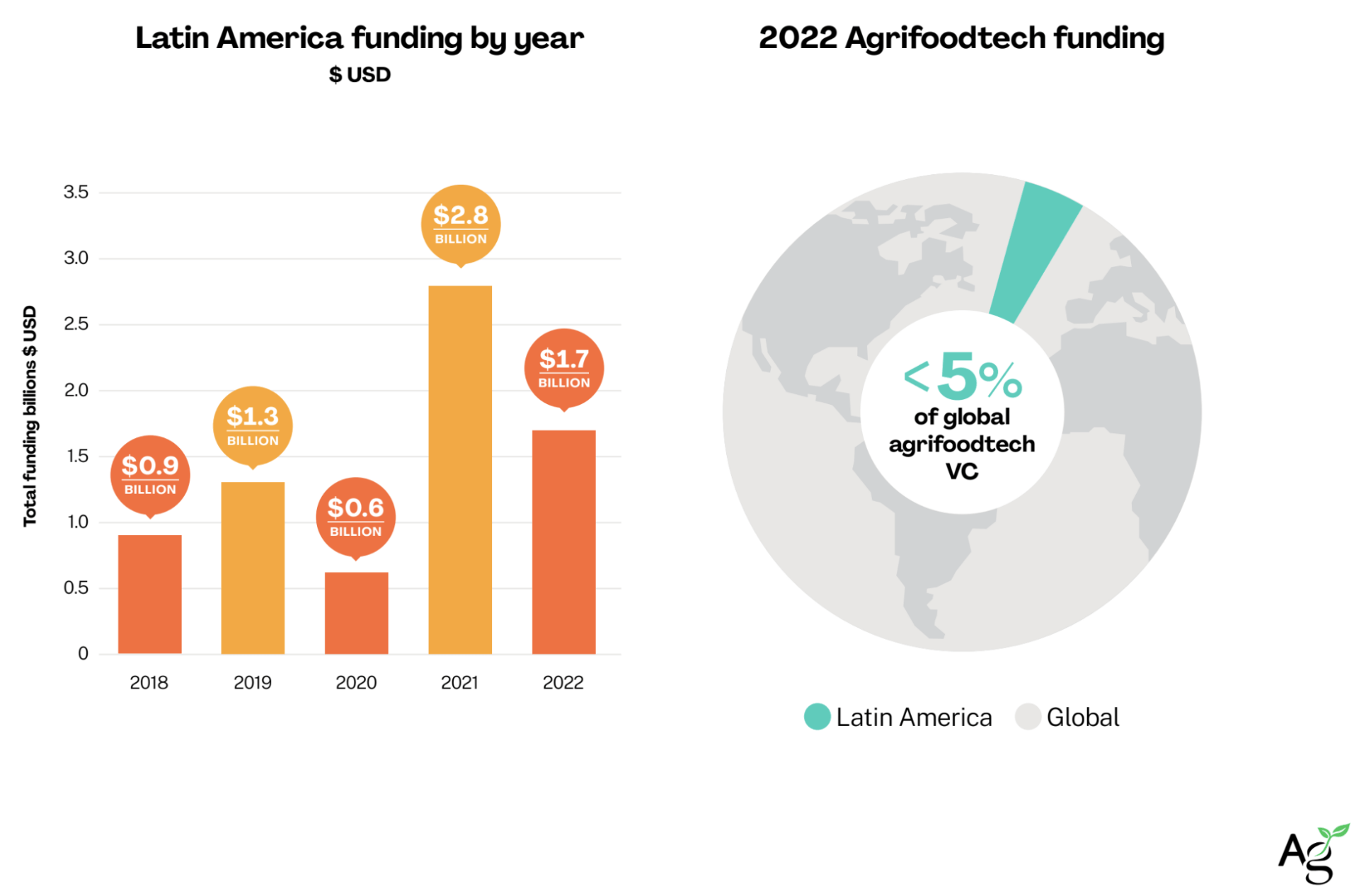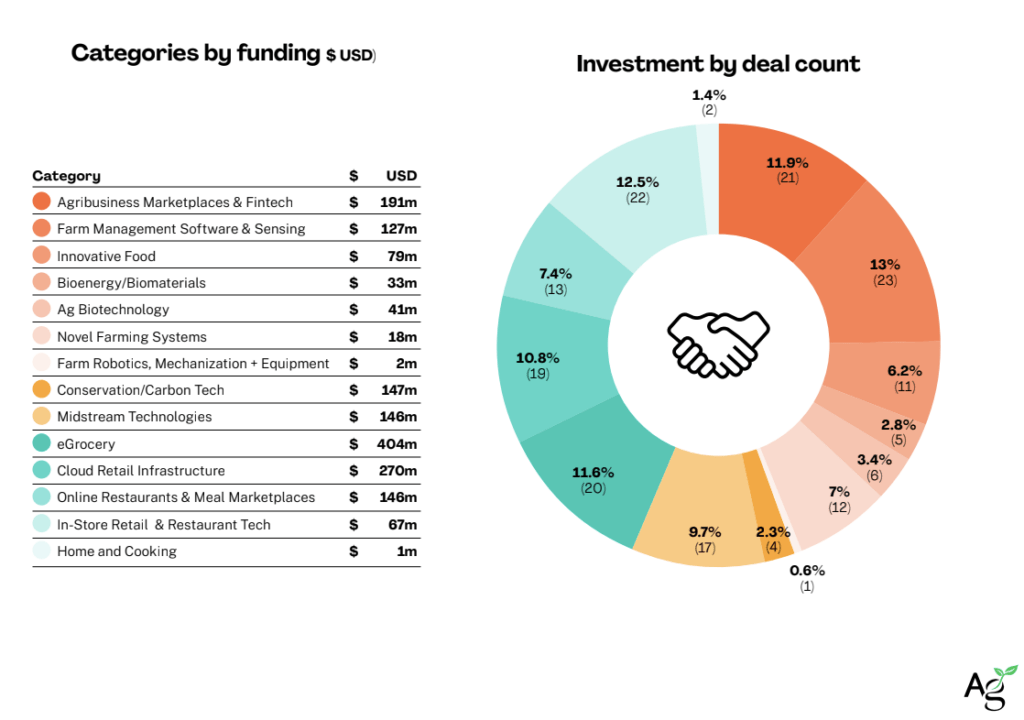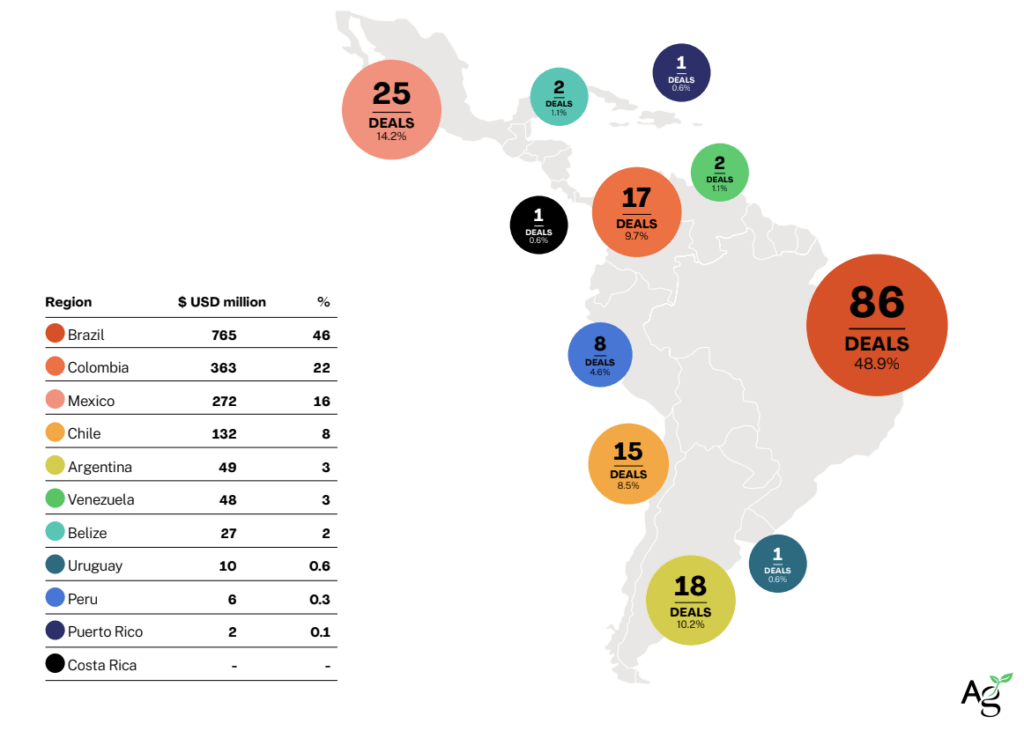Disclosure: AgFunderNews’ parent company is AgFunder.
Historically, agrifoodtech venture capital has underinvested in Latin America despite the region’s natural resources, biodiverse ecosystems and high levels of food production.
Latin America is the world’s leading soy producer and also home to 23% of global beef and buffalo production, 20% of global poultry, and important commodities like cacao and coffee. However, the region also battles economic instability, environmental damage, and inequalities in the agrifood system that leave millions hungry.
In 2023, there are signs that this is starting to change as investors better understand Latin America’s role in the global food system and why the region needs more innovation to secure food production and conserve its natural environment.
While Latin America represented just 5% of total global agrifoodtech investment in 2022, the industry accounted for a more impressive 21% of all venture capital investment in the region last year, and the numbers are creeping up, according to AgFunder‘s inaugural Latin America AgriFoodTech Investment report done in partnership with SP Ventures, Alianza Team, BASF and Cibersons.
Latin America agrifoodtech startups raised $1.7 billion in 2022, marking a 39% decline from a record-breaking 2021 in the region and globally. The pullback in investment was experienced across the globe in 2022. Since 2018, agrifoodtech startups in the region have raised $7.3 billion.

Innovating between the extremes
When viewed as a whole Latin America agrifoodtech presents an intriguing dichotomy.
As my colleague Louisa Burwood-Taylor wrote, “On one hand, you have the highly advanced and productive large-scale agricultural organizations of South America . . . on the other hand, most if not all of its countries are still considered developing countries, with a smallholder farming population of 14 million producing 50% of the region’s food.”
Latin America is also the fourth-largest food producer and second-largest food exporter in the world, yet millions within its borders can’t access a healthy diet. It’s the most biodiverse region on the planet and at the same time home to rampant deforestation.
Much of the innovation happening in Latin American agrifoodtech is about the opportunities between these extremes. For example, more farmers are now looking for digital solutions to improve their operations, BASF’s Almir Araújo recently told AFN. Improving access to tech for smallholder farmers could have positive impacts on their livelihoods and economic status.
Where did the money go?
Funding for agrifoodtech is also a set of extremes in Latin America, with the largest amounts going to two categories at polar opposites of the supply chain: eGrocery and Ag Marketplaces & Fintech.
The former was the strongest downstream category in 2022, propped up by Mexico-based online grocery retailer Jüsto‘s $152 million Series B.
Jüsto stands out amongst eGrocery startups — in the region and elsewhere — because of its mission to eliminate intermediaries that can often impact pricing, transparency and other factors.
“We are transforming the industry through technology, innovation and fair practices,” the company notes in a Q&A within AgFunder’s inaugural Latin America report. “[We are] showing that we can deliver good quality food, with great service and in a more efficient and fair way regarding our suppliers, the community, our own team and the environment.” [Disclosure: AgFunder, AgFunderNews’ parent company, is an investor in Justo.]
Ag Marketplaces & Fintech was the best-funded upstream category, with Brazil’s Agrolend raising nearly $100 million during the year. Interestingly, reducing dependence on supply chain intermediaries is a goal of many agribusiness marketplaces and fintech startups, too, making it one of the most important areas of agrifoodtech investment in the region.
While many of these developments are promising, as is the growing ecosystem of dedicated investors, accelerators and events, as Burwood-Taylor noted in the report, “it would be good to see more deep tech, deep science and first mover innovation that capitalizes on Latin American creativity.” Just $41 million of investment in the Ag Biotech category and only $2 million for Farm Robotics and Automation, are two disappointing signals.

New category: conservation tech
The conservation of ecosystems is critical in Latin America, home to 60% of global terrestrial life in addition to vast amounts of land and water resources. As US climate envoy John Kerry noted earlier this year, failure to protect the Amazon rainforest would make it impossible to limit global warming to 1.5 degrees Celsius.
Conservation efforts vary wildly from country to country, however.
Costa Rica, for example, has a National Decarbonization Plan and is widely recognized as a leader in forest conservation, having reversed deforestation over the last several years.
On the other end of the boat, Brazil has seen deforestation surge thanks to major cuts made to environmental protection efforts and past leadership decisions, although the new government has recently launched a series of initiatives to stop deforestation by 2030.
Despite this — or perhaps because of it — Brazilian startups lead the charge when it comes to conservation technologies, with the top deals in this category all going to startups in that country: re.green, Carbonnext, Mombak, and Moss.
By geography
Geographically, Brazil and Chile are home to a diverse set of agrifoodtech startups ranging from biotech to alternative proteins, e-commerce and biomaterials. Colombia has little diversity, mostly focusing on downstream innovations near to the consumer, while Mexico is gradually broadening its scope beyond just downstream activities and incorporating a bio-energy angle. Argentina is known for exporting its founders to other parts of the world and rapidly expanding its companies beyond the country’s borders.

While this report was always intended to be a brief, initial overview of Latin America agrifoodtech, we hope it gives you a good flavor of the region’s trends ahead of a more extensive, in-depth report in 2024. If you’d like to be a partner on that report, please email [email protected].




